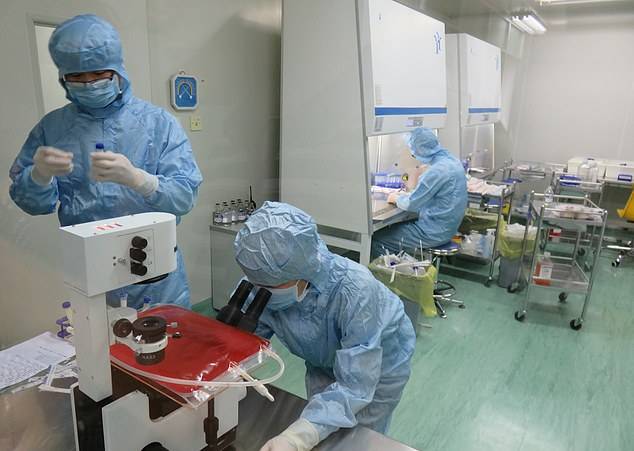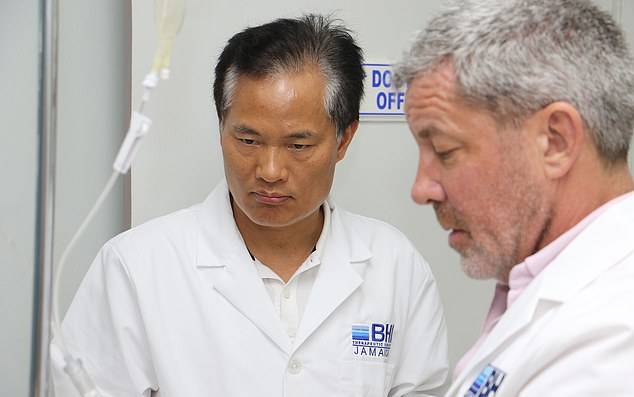A Chinese doctor who runs a lab in Wuhan – ground zero of the coronavirus pandemic – claims he could save thousands of lives after making a breakthrough in the treatment of the deadly pathogen, DailyMailTV can reveal. Dr. Dongcheng Wu, an expert in stem cell therapy, said he has successfully treated nine patients who were hospitalised with novel coronavirus pneumonia. The patients, mostly elderly, had developed serious breathing issues as well as overwhelming inflammation in their lungs before they volunteered for Dr. Wu’s medical trial earlier this month in Wuhan. Alongside conventional treatment, Dr. Wu infused Human Umbilical Cord Mesenchymal Stem Cells (UC-MSCs) directly into all nine patients’ veins. It’s claimed they all made a complete recovery within days of receiving the treatment. News of the breakthrough only reached Dr. Wu, who is partnered with American stem cell company Blue Horizon International (BHI), early last week. In an exclusive interview, the scientist told DailyMailTV: ‘This treatment could potentially save thousands upon thousands of lives, so naturally we are very happy with these results. ‘Yes, it is a cure, but it is still very early in the process and we still have work to do. ‘We need to finish the clinical trials to confirm whether the stem cell therapy is safe and efficacy to treat novel coronavirus pneumonia.’ Stem cells, often dubbed the building blocks of life, are cells that have the ability to develop into different cell types. They can also help repair damaged tissue. Scientists can take stem cells from adult tissue such as bone marrow but the most controversial type are embryonic stem cells, which come from human embryos. Dr. Wu and BHI only use stem cells taken from the umbilical cord placenta, which is considered throw away tissue. Dr. Brian Mehling, co-founder of BHI, is working closely with Dr. Wu on the research and said the results of the medical trials are ‘astounding’. ‘As the coronavirus outbreak unraveled, coincidentally it started in Wuhan, China which is where our stem cell labs have been for over a decade,’ he explained. ‘A lot of people were coming down with severe pulmonary pneumonia, pulmonary fibrosis and ultimately they were dying. ‘But it’s not the viral load that kills them it’s the pulmonary complications that develop, just like influenza. ‘So our research found that stem cells are extremely effective in decreasing inflammation and also enabling the body to repair damaged tissue. ‘So we thought what the heck, let’s give it a shot. We gave nine patients, who were in hospital with severe, acute pulmonary dysfunction, we gave them core blood stem cells via IV and 100 percent of them got better, so of course we were astounded.’

Dr. Wu and Dr. Mehling said that since their breakthrough the Chinese Government has approved and fast tracked clinical trials for the treatment. And Dr. Wu’s company, Wuhan Hamilton Biotechnology-Co.,LTD, has already received more than $5 million Chinese Yuan ($715,000) in government funding to begin research protocols, with more money expected to come in. Dr. Wu is Chief Science Officer for New York-based BHI, which he is working with to seek the approval needed for clinical trials in the U.S. Sadly, the scientist said it could take months before the treatment officially hits the mass market in China or the U.S. The breakthrough, however, could bring about a sea change in how coronavirus is tackled in the future and is a sign of hope for the most vulnerable. Right now there is no known effective treatment in clinical practice. Coronavirus brings about mild flu-like symptoms in most people, but for the elderly or those with underlying medical conditions, it can be deadly. Speaking to the effectiveness of the treatment, Dr. Wu said: ‘It seems that the key to cure the pneumonia is to inhibit the inflammatory response, resulting to reduce the damage of cells and repair the function of the lung. ‘UC-MSCs can significantly reduce inflammatory cell infiltration and inflammatory factors expression in lung tissue, and significantly protect lung tissue from virus-induced acute lung injuries.’ The UC-MSCs are manufactured by Dr. Wu’s company at a lab in Wuhan and comply with the requirements of China’s medical gold standard – Volume Ⅲ of the Pharmacopoeia of the People’s Republic of China (2015 Edition). The doctor says his product has also passed the quality test of China’s National Institutes of Food and Drug Control (NIFDC) and his firm is currently the only stem cell institution in the Hubei province. BHI is moving quickly to seek the necessary Food and Drug Administration approvals in the U.S. Dr. Mehling says they have submitted the retrospective study data to an investigational review board (IRB) and once the study receives a rubber stamp, a research paper will be written for publication. His firm is also submitting a FDA protocol and applying for a study which they believe will be approved quickly due to the severe nature of the crisis. Dr. Mehling said because his company has spent 10 years researching stem cell therapy, a treatment which he says is already ‘proven’ and ‘tested’, he believes their coronavirus treatment will be ‘ready to deploy’ sooner rather than later. Dr. Mehling, an orthopedic surgeon, said his firm is also about to publish a long-term safety study on stem cell therapy in which 30 patients received multiple doses over a seven to eight year period with no significant complications. BHI already has two approved clinical trials for UC-MSCs treating osteoarthritis and diabetic nephropathy. Dr. Wu said he has 400 doses of stem cells stockpiled in Wuhan and another 400 could be manufactured within three weeks to help tackle the coronavirus pandemic. BHI, which has offices in Europe and the Caribbean, also has plans in place for international expansion to make the coronavirus treatment available to as many people as possible, as quickly as possible. With the right infrastructure and supply chain in place, the company will also be able to roll out treatment for dozens of other conditions around the world. But former director of the US Centers for Disease Control and Prevention and former commissioner of the New York Health Department, Dr Tom Frieden, told DailyMail.com that the CDC will need ‘clear evidence’ that any coronavirus treatment works. ‘The priority now is to learn as much as possible about this virus and what works to stop it,’ he said. ‘This will include randomized controlled trials of potential treatments, some of which may be effective. ‘Until we have clear evidence that any treatment works, and the means to deliver it to those who need it, we need to focus on what we can do now: wash our hands frequently, cover our coughs, not go out if sick, stop shaking hands, and practice social distancing. ‘Health care facilities should focus on surging safely by improving infection control, doubling or tripling intensive care capacity, and preparing to deal with large numbers of less severely ill patients and worried well, for example through screening outside in tents.’ Dr Frieden is president and CEO of Resolve to Save Lives, a global nonprofit initiative and part of the global nonprofit Vital Strategies. Serial science and technology entrepreneur Nova Spivack, who operates a coronavirus information site with a team of doctors and medical experts called germinfo.org, says the new treatment could be ‘great’ if it passes FDA protocols, but warns that it likely won’t be widely available for at least a year.

‘Even if they find it working clinically and they have permission to test it on human volunteers, at this stage, if they wanted to go through FDA approval, it will take a year at least,’ he explained. ‘A lot is happening with stem cell treatments so this doesn’t surprise me. ‘It looks to be a very promising direction and there’s a number of trials in process. ‘There are a relatively small number of patients that have been treated so it’s early days, but it’s a very astonishing direction.’ Spivack, a philanthropist and futurist, does note that while any new treatment will miss the window to treat anyone infected in the first wave of the coronavirus, it will be available for what he predicts will be second and third waves of the disease. Dr. Wu is a professor at Wuhan University School of Basic Medical Science, Chu Tian Scholar, and Director of the Stem Cell Centre, Hongqiao Brain Hospital The first cases of novel coronavirus were reported in Wuhan late last year, and until recently, China has borne the brunt of the outbreak. Almost three quarters of the more than 110,000 or so confirmed global cases are in mainland China and more than 3,000 people have died as a result of the virus, with the majority in Hubei province. The Chinese government has placed hundreds of millions of people under lockdown, while others have been unable to return to work due to travel restrictions. Stem cell research was much hyped a decade ago as the miracle cure for degenerative diseases, like Parkinson’s. But things turned sour when the therapy became mired in controversy over the use of stem cells derived from the fetuses of aborted babies. Embryonic stem cells quickly became a divisive and highly-politicized issue in the U.S. The biomedical industry relied on the malleable cells for groundbreaking research, but their use raised serious questions of morality and ethics. Today, however, the technology has moved on. Still, Dr. Mehling said stem cell research gets an incredibly bad rap because of misinformation. ‘There’s a huge biggest misconception about stem cells that has been perpetuated, a lot of people think that stem cells are involved with fetal embryonic tissue, like aborted babies, that’s just not the case,’ he said.

‘That’s something that’s happened in the past but it’s not something happening now at the forefront of stem cell medicine. ‘Fortunately today you don’t need embryonic or fetal cells to get useful stem cell lines to treat all these different diseases, so the technology has advanced to the point where it’s just not necessary to use those sources of stem cells.’ Dr. Mehling explained that the stem cells are instead taken from the placenta cord tissue of healthy babies. Another source is the patient themselves. Many experts in the field blame the pharmaceutical lobby for hindering the advancement of stem cell research in the U.S. The pharma giants realized that developing a miracle cure for dozens of serious conditions could seriously dent their revenues, for the simple reason that millions of patients would no longer be reliant on expensive medication.


RECENT COMMENTS